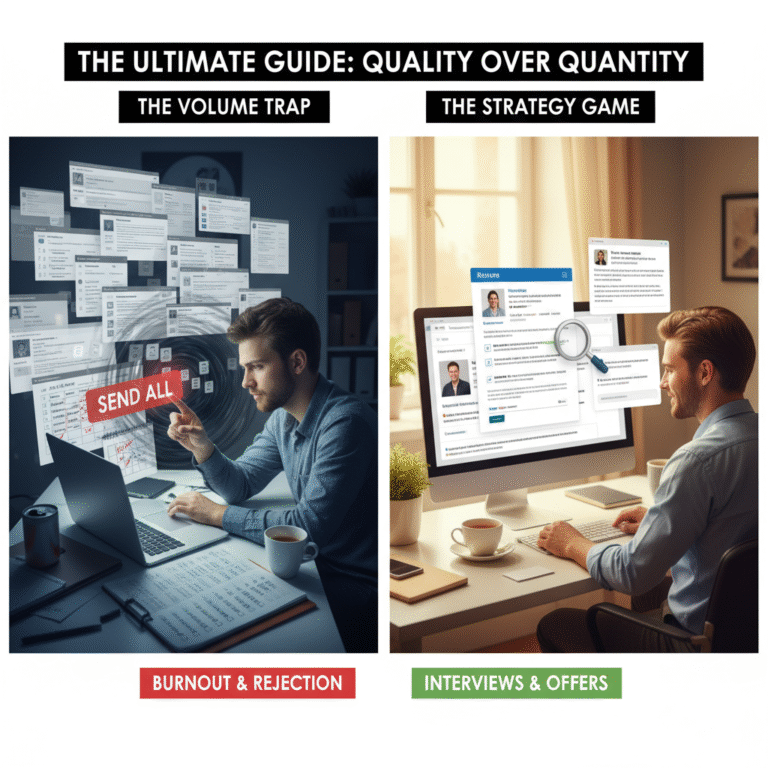How to Use AI to Find Jobs and Mass-Personalize Resumes (Without Sounding Like a Robot)
The modern job search is broken. It’s a tedious, high-volume, low-reward game. You spend hours manually tailoring your resume and writing heartfelt cover letters, only to receive an automated rejection (or, more likely, hear nothing at all). It’s exhausting. Now, Artificial Intelligence (AI) has emerged, promising to automate this entire process.
This has created two types of job seekers: those who ignore AI and get left behind, and those who use it *wrong* and get blacklisted. The “wrong” way is using AI to spam 1,000 applications with generic, robotic content. Recruiters and Applicant Tracking Systems (ATS) can spot this from a mile away. The “right” way is to use AI as a strategic co-pilot, a powerful assistant that does 80% of the grunt work, freeing you to do the 20% of high-impact human work that actually gets you the interview.
This guide is not about “cheating” the system. It’s about using the most powerful tools available to make you a more efficient, more effective, and more successful job applicant. We will teach you the art of AI-assisted mass-personalization—how to tailor 50 applications in the time it used to take you to do 5, all while sounding 100% human.
The Core Concept: “AI-Assisted” vs. “AI-Generated”
You must understand this difference, or you will fail. Recruiters are already overwhelmed with low-quality, AI-generated spam.
The Wrong Way: “AI-Generated” Spam
This is when you feed a generic prompt into an AI tool (like ChatGPT, Claude, or Gemini) and use 100% of its output.
- The Resume: A generic list of “action verbs” and skills that sounds impressive but has no substance.
- The Cover Letter: “Dear Hiring Manager, I am a highly motivated individual…” It’s filled with clichés and has zero personality or specific knowledge of the company.
Result: Your application is instantly flagged by the ATS or deleted by the human recruiter in under 5 seconds. It shows zero effort.
The Right Way: “AI-Assisted” Personalization
This is a partnership. The AI handles the “data processing” (analyzing, summarizing, drafting), and you handle the “strategy” (prompting, editing, adding the human touch).
- The AI’s Job: Analyze job descriptions, cross-reference them with your “master resume,” draft targeted bullet points, and create a solid “80% done” cover letter.
- Your Job: Provide the AI with high-quality input, edit its output for tone, and add the crucial 20%—a specific anecdote, a personal connection to the company’s mission, or a strategic insight.
Result: A perfectly tailored application that passes the ATS *and* impresses the human recruiter, all created in 10-15 minutes instead of an hour.
Step 1: Create Your “Master Resume” (Your Human Input)
Your AI is only as good as the data you give it. You must first create a “Master Resume.” This is not the 1-page document you send out. This is a 5-10 page “brag sheet” or personal database. It lists everything you’ve ever done:
- Every job title
- Every project, with details (use the STAR method: Situation, Task, Action, Result)
- Every tool you’ve ever used (Software, platforms, etc.)
- Every certification or course completed
- Every measurable achievement (e.g., “Increased blog traffic by 15%”)
This document is your “ammunition.” You will copy/paste relevant parts of this into the AI for every new application.
Step 2: The “AI-Powered Targeted Resume” in 5 Minutes
This is where the magic happens. Your goal is to mirror the keywords from the Job Description (JD) in your resume, so the ATS gives you a 95%+ match score.
Open your AI tool and use this two-part prompt:
Prompt 1: Decode the Job
“You are an expert ATS and an executive recruiter. Analyze the job description below and extract two lists: 1. The Top 10 ‘Must-Have’ keywords and hard skills. 2. The Top 5 ‘Hidden’ soft skills or cultural values this company is looking for.
[Paste Job Description Here]”
Prompt 2: Generate Targeted Bullet Points
“Excellent. Now, you are a professional resume writer. Here are my relevant skills and experience from my Master Resume:
[Paste 2-3 paragraphs from your Master Resume that are relevant to this job]
Using *only* the information I provided, rewrite 5-7 bullet points for my ‘Work Experience’ section. Each bullet point must be a measurable achievement and must *naturally* include the ‘Must-Have’ keywords you identified. Make them sound professional, confident, and human.”
Your 20% Human Polish: The AI will give you 7 great bullet points. Pick the best 4-5, check them for accuracy, and paste them into your resume template. You just did an hour of work in 3 minutes.
Step 3: The “80/20” Cover Letter (AI Draft, Human Polish)
A good cover letter is not about your life story; it’s about solving the company’s problem. Use this prompt.
Prompt: The “Problem-Solving” Cover Letter Draft
“Now, write a 3-paragraph cover letter for this role. Do not use generic clichés like ‘highly motivated.’
- Paragraph 1: State my excitement for the [Role] and [Company] and mention 1 specific reason why I admire the company (use its mission statement from the JD).
- Paragraph 2: This is the key. Identify the main *problem* this role solves (from the JD). Then, connect 2-3 of my bullet points (from the previous step) to show how I am the *solution* to that problem.
- Paragraph 3: A confident call to action. ‘I am eager to discuss how my experience in [Key Skill] can help [Company Goal].’
Keep it professional, concise, and human.”
Your 20% Human Polish: This is *critical*. The AI will give you a 9/10 draft. You must add the 10/10. Find the hiring manager’s name on LinkedIn and use it. Add one simple, genuine sentence that the AI could never know.
Example: “P.S. I’ve been a user of your app for three years, and the new [X Feature] is a brilliant update. I’d be thrilled to be part of the team that makes it even better.”
That one sentence proves you are not a robot and instantly builds rapport.
Step 4: Use AI for God-Tier Interview Prep
The AI’s job isn’t over. Once you get the interview (and you will), use these prompts.
- The Mock Interview: “You are the hiring manager for [Company]. I am interviewing for the [Role]. Ask me 10 tough behavioral questions based on the job description. After I answer each, give me feedback and suggest a stronger answer.”
- The Company “Briefing Book”: “Summarize [Company]’s last quarterly earnings report, identify their 3 biggest stated challenges, and list their main competitors. I am interviewing there, and I need to sound like an expert.”
- The “Smart Questions” List: “What are 5 insightful, non-obvious questions I should ask the interviewer at the end of our conversation? The questions should show I am strategic, long-term, and serious about this role.”
Conclusion: AI Is a Lever, Not a Magic Wand
Using AI in your job search is not about being lazy. It’s about being *smart*. It’s about automating the low-value, repetitive tasks (like data entry and first drafts) so you can pour your human energy into the high-value tasks (like strategy, editing, and building human connection).
The job seekers who “spray and pray” with 100% robotic content will fail. The job seekers who refuse to use AI will be outpaced. The winner will be the “AI-Assisted” applicant—the person who uses AI as a co-pilot to personalize at scale, sound perfectly human, and prove their value before they even walk in the (virtual) door.






